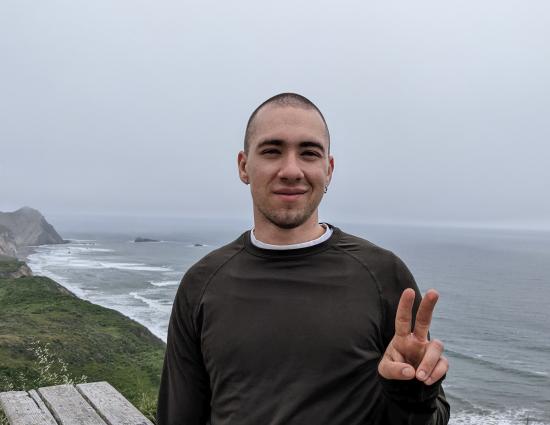Ellis Martin is a first-year MIMS student working in the interstices of art, archives and information and as a collections and digitization associate at the nonprofit Letterform Archive. Prior to the I School, Ellis received his bachelor's in visual and critical studies from Mills College. He has extensive experience in cataloging, editing, and curating art and literature by queer and trans artists.
Why did you choose the I School and the MIMS program?
I was drawn to the I School because of its history as the School of Library and Information Studies. I come from cultural heritage digitization in museums and archives so the traditional path for me would have been to complete a Library and Information Science degree. I instead chose the MIMS program because I wanted to shift my relationship to art, archives, and information with an enhanced technical toolkit. MIMS features an entry point into programming alongside the necessary frameworks to critically enact technologies, a combination that I find extremely compelling.
What has been the most surprising thing about your experience here so far?
I have been so delighted by the depth and breadth of expertise within the I School’s faculty, students and staff. I have been especially impressed to see how everyone is so willing to share their knowledge whether that be through class discussion, by participating in a survey for a student project, or by sharing current tech news articles to keep people informed on the I School Slack. Since everyone comes to the I School on such different paths, the connections between different specialities within the School are uniquely generative.
What is an information or data science challenge that intrigues you?
I am intrigued by the potential of machine learning to reveal patterns within historical data, going beyond what can be seen in snapshots of the data or manual analysis. Currently, I’m working with trans historian Dr. Susan Stryker and Stanford post-doctoral researcher Dr. Federico Bianchi to reconsider the history of the gender concept in the English language. By employing natural language processing methods, we hope to demonstrate how the gender concept moved beyond grammatical gender and evolved to become a language and framework of embodiment.
What does Pride/Pride Month mean to you? Do you recognize or celebrate it? If so, how?
This June I want to take time both to celebrate with my queer, trans family, and to increase my awareness of current trans and nonbinary struggles for autonomy, healthcare and rights. Dr. Susan Stryker and Dr. Gayle Rubin both taught me the importance of understanding political opposition, so I am committed to spending time this Pride Month learning more about the more than 520 anti-LGBTQ+ bills already introduced this year in the United States.
What advice would you give an incoming or prospective MIMS student?
- Get involved in something larger than yourself while you’re on campus. We are so lucky to be on a campus that has labs, clubs, organizations, sports and activities for all sorts of interests. Rowing on the lightweight team at Cal has brought friends from many departments and taught me new ways to show up as a teammate. It also offers a chance to refocus my energies and get into my body when I am feeling overwhelmed or stressed.
- Get out into Bay Area nature, whatever that means for you. There are many different natural wonders such as the ocean, redwood forests, a volcanic center, a giant urban park, gardens, marshlands, etc. You can even catch the Clark Kerr Fire Trail, a fabulous place to watch the sunset, from the southside of campus.












